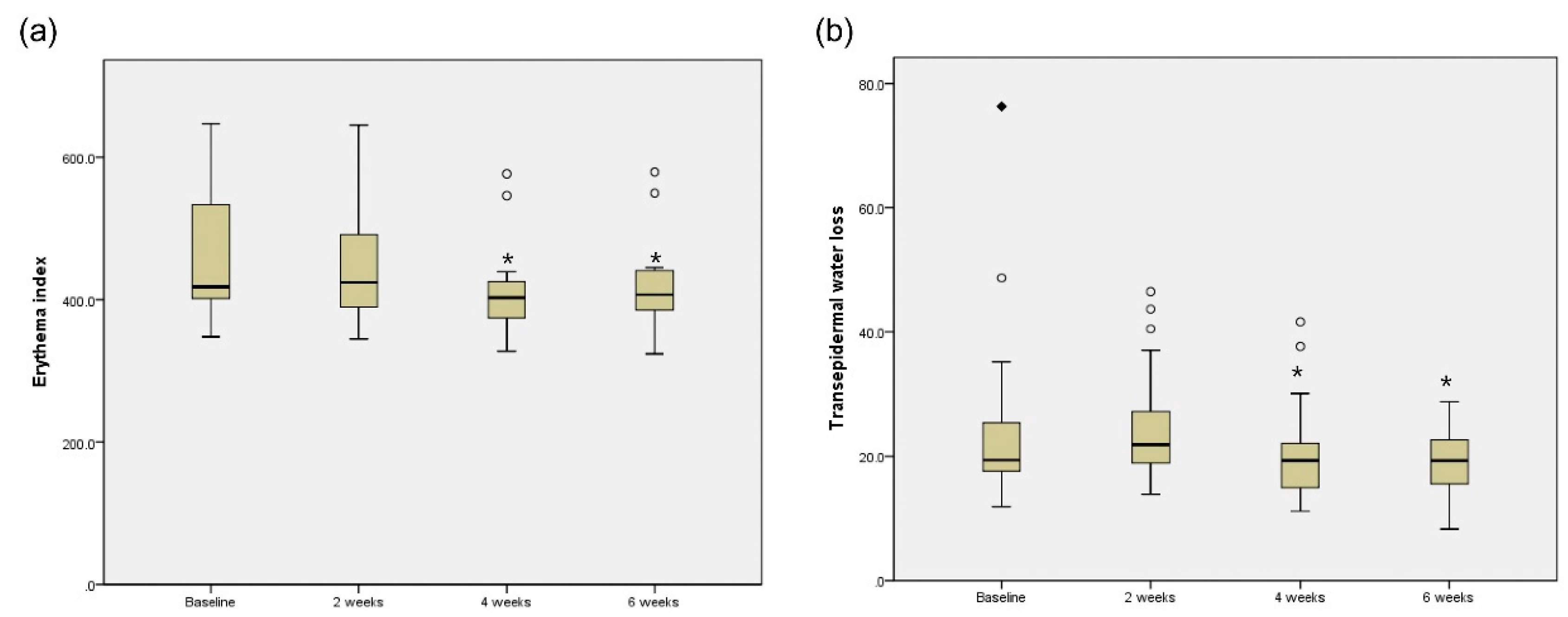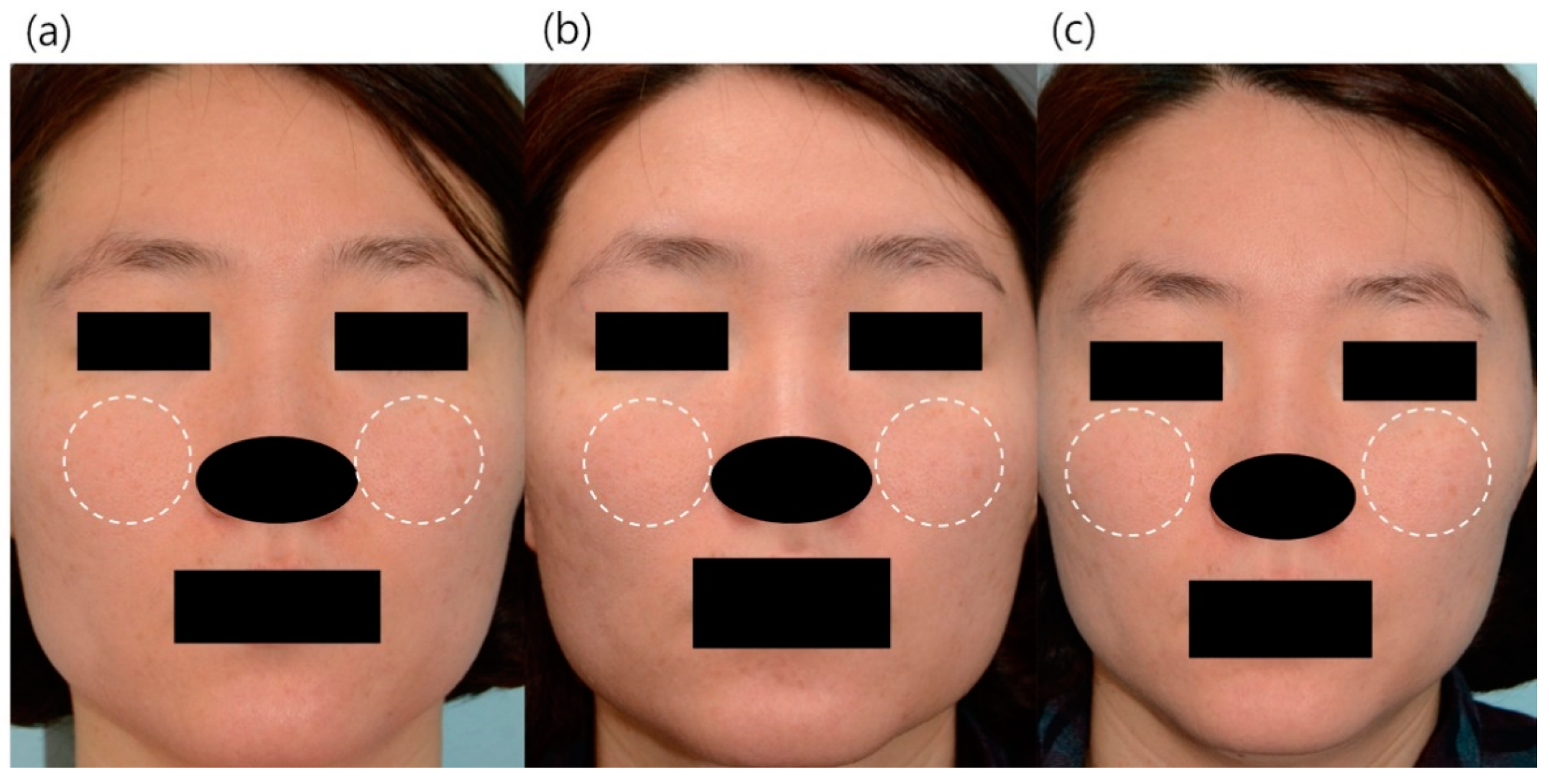The Efficacy and Safety of Dual-Frequency Ultrasound for Improving Skin Hydration and Erythema in Patients with Rosacea and Acne
Abstract
1. Introduction
2. Materials and Methods
2.1. Subjects
2.2. Treatment Protocol
2.3. Efficacy Evaluation
2.4. Safety Evaluation
2.5. Statistical Analysis
3. Results
4. Discussion
5. Conclusions
Author Contributions
Funding
Institutional Review Board Statement
Informed Consent Statement
Conflicts of Interest
References
- Tanghetti, E.A.; Jackson, J.M.; Belasco, K.T.; Friedrichs, A.; Hougier, F.; Johnson, S.M.; Kerdel, F.A.; Palceski, D.; Hong, H.C.-H.; Hinek, A.; et al. Optimizing the use of topical brimonidine in rosacea management: Panel recommendations. J. Drugs Dermatol. JDD 2015, 14, 33–40. [Google Scholar]
- Brzezinski, P.; Borowska, K.; Chiriac, A.; Smigielski, J. Adverse effects of isotretinoin: A large, retrospective review. Dermatol. Ther. 2017, 30, e12483. [Google Scholar] [CrossRef] [PubMed]
- Park, J.Y.; Ahn, M.K.; Cho, E.B.; Park, E.J.; Kim, K.H. Dual-Frequency Ultrasound as a New Treatment Modality for Refractory Rosacea: A Retrospective Study. Dermatol. Surg. 2018, 44, 1209–1215. [Google Scholar] [CrossRef]
- Sontag, W.; Kruglikov, I.L. Expression of Heat Shock Proteins after Ultrasound Exposure in HL-60 Cells. Ultrasound Med. Biol. 2009, 35, 1032–1041. [Google Scholar] [CrossRef]
- Meyer-Rogge, D.; Frank, R. Facial Skin Rejuvenation with High Frequency Ultrasound: Multicentre Study of Dual-Frequency Ultrasound. J. Cosmet. Dermatol. Sci. Appl. 2012, 2, 68–73. [Google Scholar] [CrossRef]
- Gibbons, G.W.; Orgill, D.P.; Serena, T.E.; Novoung, A.; O’Connell, J.B.; Li, W.W.; Driver, V.R. A prospective, randomized, controlled trial comparing the effects of noncontact, low-frequency ultrasound to standard care in healing venous leg ulcers. Ostomy Wound Manag. 2015, 61, 16–29. [Google Scholar]
- Park, H.; Kim, E.; Kim, J.; Ro, Y.; Ko, J. High-Intensity Focused Ultrasound for the Treatment of Wrinkles and Skin Laxity in Seven Different Facial Areas. Ann. Dermatol. 2015, 27, 688–693. [Google Scholar] [CrossRef] [PubMed]
- Ko, E.J.; Hong, J.Y.; Kwon, T.-R.; Choi, E.J.; Jang, Y.-J.; Choi, S.Y.; Yoo, K.H.; Kim, S.Y.; Kim, B.J. Efficacy and safety of non-invasive body tightening with high-intensity focused ultrasound (HIFU). Ski. Res. Technol. 2017, 23, 558–562. [Google Scholar] [CrossRef] [PubMed]
- Saket, P.; Shobeihi, S.; Mehrdadi, S. Study of efficacy of esthetic High-Intensity Focused Ultrasound system on Iranian skin for reducing the laxity and wrinkles of aging. J. Cosmet. Dermatol. 2017, 16, 336–341. [Google Scholar] [CrossRef] [PubMed]
- Dréno, B. What is new in the pathophysiology of acne, an overview. J. Eur. Acad. Dermatol. Venereol. 2017, 31, 8–12. [Google Scholar] [CrossRef]
- Steinhoff, M.; Schauber, J.; Leyden, J.J. New insights into rosacea pathophysiology: A review of recent findings. J. Am. Acad. Dermatol. 2013, 69, S15–S26. [Google Scholar] [CrossRef] [PubMed]
- Meyer-Rogge, D.; Kruglikov, I.L. Pilot Study into Super-Fractionation Treatment Strategy of Acne and Rosacea. J. Cosmet. Dermatol. Sci. Appl. 2013, 3, 197–202. [Google Scholar] [CrossRef]
- Ahn, C.S.; Huang, W.W. Rosacea Pathogenesis. Dermatol. Clin. 2018, 36, 81–86. [Google Scholar] [CrossRef] [PubMed]
- Jalian, H.R.; Liu, P.T.; Kanchanapoomi, M.; Phan, J.N.; Legaspi, A.J.; Kim, J. All-Trans Retinoic Acid Shifts Propionibacterium acnes-Induced Matrix Degradation Expression Profile toward Matrix Preservation in Human Monocytes. J. Investig. Dermatol. 2008, 128, 2777–2782. [Google Scholar] [CrossRef] [PubMed]
- Bonamigo, R.R.; Bakos, L.; Edelweiss, M.; Cartell, A. Could matrix metalloproteinase-9 be a link between Demodex folliculorum and rosacea? J. Eur. Acad. Dermatol. Venereol. 2005, 19, 646–647. [Google Scholar] [CrossRef] [PubMed]
- Cho, N.J.; Kyoo, J.S.; Jun, J.E.; Choi, K.J.; Park, S.J.; An, H.J.; Ahn, S.K.; Lee, S.H. The Effect of Ultrasound on Epidermal Permeability Barrier and Lipid Synthesis. Korean J Dermatol. 2005, 43, 619–629. [Google Scholar]
- Kost, J.; Langer, R. Ultrasound-Mediated Transdermal Drug Delivery. In Topical Drug Bioavailability, Bioequivalence, and Penetration; Springer International Publishing: Berlin/Heidelberg, Germany, 1993; pp. 91–104. [Google Scholar]



| Characteristics | Facial Erythema Mainly with Acne | Facial Erythema Mainly with Rosacea | Total |
|---|---|---|---|
| Total patients, n | 11 | 15 (ETR:10, PPR:3, Mixed:2) | 26 |
| Age, y (mean ± SD) | 28.6 ± 6.2 | 43.2 ± 8.4 | 37.0 ± 10.4 |
| Sex ratio (male : female) | 6 : 5 | 3 : 12 | 9 : 17 |
| Baseline erythema index | 523.0 ± 147.8 | 450.7 ± 91.7 | 461.8 ± 97.8 |
| Erythema index at 6 weeks follow-up | 493.5 ± 121.6 (p = 0.18) | 409.1 ± 59.3 (p = 0.023) | 422.1 ± 71.9 (p = 0.010) |
| Baseline TEWL index | 20.8 ± 6.3 | 26.9 ± 16.7 | 24.3 ± 13.5 |
| TEWL index at 6 weeks follow-up | 18.6 ± 6.0 (p = 0.290) | 19.2 ± 5.0 (p = 0.036) | 18.9 ± 5.3 (p = 0.020) |
| Baseline CEA score | 2.72 ± 0.90 | 2.40 ± 0.51 | 2.53 ± 0.71 |
| CEA score at 6 weeks follow-up | 1.54 ± 0.93 (p = 0.023) | 1.67 ± 0.62 (p = 0.002) | 1.61 ± 0.75 (p < 0.001) |
| Baseline SSQ score | 2.82 ± 0.87 | 2.53 ± 0.83 | 2.65 ± 0.84 |
| SSQ score at 6 weeks follow-up | 2.27 ± 0.78 (p = 0.058) | 2.06 ± 0.79 (p = 0.020) | 2.15 ± 0.78 (p = 0.003) |
Publisher’s Note: MDPI stays neutral with regard to jurisdictional claims in published maps and institutional affiliations. |
© 2021 by the authors. Licensee MDPI, Basel, Switzerland. This article is an open access article distributed under the terms and conditions of the Creative Commons Attribution (CC BY) license (http://creativecommons.org/licenses/by/4.0/).
Share and Cite
Kim, Y.J.; Moon, I.J.; Lee, H.W.; Won, C.H.; Chang, S.E.; Lee, M.W.; Choi, J.H.; Lee, W.J. The Efficacy and Safety of Dual-Frequency Ultrasound for Improving Skin Hydration and Erythema in Patients with Rosacea and Acne. J. Clin. Med. 2021, 10, 834. https://doi.org/10.3390/jcm10040834
Kim YJ, Moon IJ, Lee HW, Won CH, Chang SE, Lee MW, Choi JH, Lee WJ. The Efficacy and Safety of Dual-Frequency Ultrasound for Improving Skin Hydration and Erythema in Patients with Rosacea and Acne. Journal of Clinical Medicine. 2021; 10(4):834. https://doi.org/10.3390/jcm10040834
Chicago/Turabian StyleKim, Young Jae, Ik Jun Moon, Hae Woong Lee, Chong Hyun Won, Sung Eun Chang, Mi Woo Lee, Jee Ho Choi, and Woo Jin Lee. 2021. "The Efficacy and Safety of Dual-Frequency Ultrasound for Improving Skin Hydration and Erythema in Patients with Rosacea and Acne" Journal of Clinical Medicine 10, no. 4: 834. https://doi.org/10.3390/jcm10040834
APA StyleKim, Y. J., Moon, I. J., Lee, H. W., Won, C. H., Chang, S. E., Lee, M. W., Choi, J. H., & Lee, W. J. (2021). The Efficacy and Safety of Dual-Frequency Ultrasound for Improving Skin Hydration and Erythema in Patients with Rosacea and Acne. Journal of Clinical Medicine, 10(4), 834. https://doi.org/10.3390/jcm10040834






